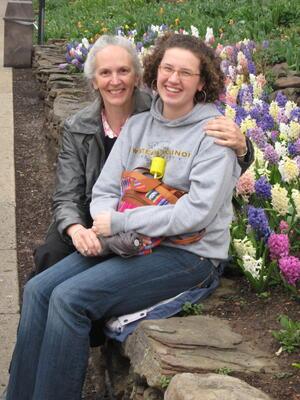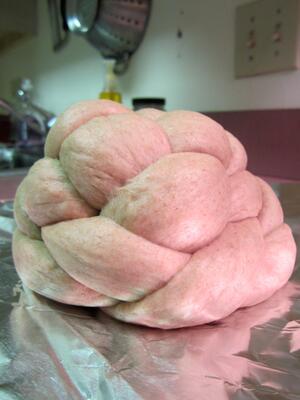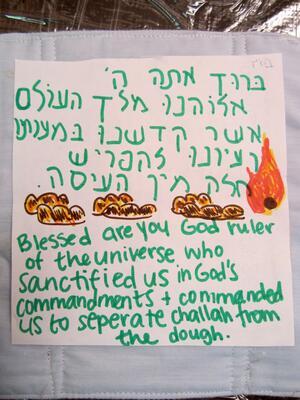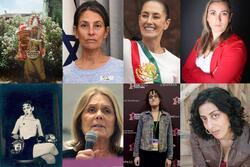Righteously bouncing back: What baking challah means to me
The first thing you should know about making challah is this: DO NOT BE AFRAID! I find that many people are intimidated by the thought of making their own challah. Something about the combination of rising yeast, kneading dough, braiding strands, and then serving it up to family sends people into a tizzy of self-doubt and fear. Well, fear no more! What better way to begin the New Year than to take on a new tradition and learn a new skill that will connect you to Jews across the world, and across time?
Now, everyone insists that their own mother or grandmother makes the best challah. This is cute, but it is also false. MY mother makes the best challah. And now you can too! Before I get to the recipe, however, I would like to say a few things about the practice of making challah.
During my Junior year of college, I found myself living with a woman named Abby whose religious practice was more traditional than my own. I was daunted by the task of keeping a kosher kitchen and remembering to leave the light on in the bathroom on Shabbat. Like many other people I know, my increased awareness of Jewish law and custom triggered anxiety and embarrassment about the limits of my own knowledge and practice. I now believe that our match was beshert, or destined. The passion with which Abby approached the every-day rituals of life, and her commitment to making her life spiritually meaningful, inspired me to begin creating rituals of my own, like making challah. Making challah led to cooking Shabbat dinner which led to inviting people over every week and now I’m joyfully stuck with hosting 16 people in my tiny apartment for Rosh Hashanah!
Interestingly enough, Abby taught me that the word “challah” actually refers to the portion of dough that is removed and burned when the dough is divided in preparation for braiding. This act is one of the three traditional women’s mitzvot (along with lighting the Shabbat candles and going to the mikveh. A practice rooted in biblical times, we burn the challah in lieu of giving it to the Kohanim (priests) and their families. You only have to remove the portion (the size of an egg or an olive depending on who you ask) for the challah if you are using over 2.2 pounds of flour. If you are using more than 5 pounds of flour, you must also recite a blessing (see picture). The egg-size portion is then burned in a piece of foil in the oven or wrapped completely, then thrown in the trash. If you would like to read more about this practice, check out Rebbetzin Tzipporah Heller’s article on Aish.com.
I didn’t start baking challah in college. In fact, I’m pretty sure I started at birth. Every Friday, my mother Yael would bake challah in the home-preschool she ran out of our basement where the yeasty smell of rising bread undoubtedly mingled with tiny voices arguing over cookie cutters and patient reminders not to eat too much of the unbaked dough. She was often recruited by families and congregations to make challah for special occasions and I remember the foot-long loaves she made with the bar-mitzvah boy’s name delicately sculpted along the top. On any given Friday, you might find my mom driving around with a giant metal bowl in her back seat, carrying the dough as she visits her occupational therapy clients, baking it in the oven at work, and delivering the loaf to an unsuspecting sales clerk or waiter that did a favor or a mitzvah throughout the week.
Throughout the many twists and turns of her adult life, my mom has kept the tradition of making challah, and the smell that wafts from my oven each week makes me feel connected to her and to the tremendous love she has for me, and for our family. She proudly shares the recipe with anyone, she answers my phone calls and fields questions when the yeast doesn’t rise or the dough is too wet, and she drives cross-town or stays up all night to make sure that someone deserving gets a loaf when they need it. For me, the weekly ritual of kneading, braiding, and baking serves as a reminder of the greatest lessons my mom has taught me: That there is room for everybody in our big tent of Jewish practice and that we are never to busy to stop and smell the challah. I hope that in sharing this tradition with you, and arming you with some insider tips, you’ll find that your soul, and your stomach, are quite full this New Year.
Challah (as Yael makes it, since the 1970s)
Originally found in one of James Beard’s bread books under “Rachael’s (or was it Rebecca’s?) Challah.”
Mix/dissolve in a tall water glass (12-16 oz capacity) and let it stand until it reaches rim of the glass:
¾ c warm water
2 tsp sugar
2 tbsp flour
2 packs or 3 tsp of dry yeast (more on yeast)
While the yeast-stuff does its thing, use a large bowl to mix:
4 c flour (if you use whole wheat, I’d advice no more than a quarter of the total flour amount, which is anywhere from 7-12 cups depending on the freshness of the flour, the humidity, etc.)
½ c sugar (if you use honey, dough may be a little denser)
2 tbsp coarse kosher salt (1 tbsp if using regular table salt)
2 eggs
½ c oil (safflower or peanut are best...)
1&1/2 c warm water
-
Stir in one direction until satiny-smooth…when the yeast stuff reaches the glass’ rim, stir that in, also, until satiny-smooth.
-
Then, add flour, beginning with 2 c flour and then ½ c at a time, until dough is righteously bouncing back. You’ll begin this by mixing and gradually work up to the consistency for kneading. You’ll likely use 8-10 c of flour.
-
When bouncy and popping air bubbles, turn into an oiled bowl (approx 1/8-1/4 c oil) and flip right side up so all dough’s surface is oiled.
-
Cover, with plastic wrap or a clean, smooth-fabric towel. Let rise 1 & ½ hrs or until doubled…or until you can get back to it. You DO want to put it into a big enough bowl and cover it tightly, since if it DOES rise for a long time, it could bust out of the plastic and the it’d be dried out and you’d be trimming those pieces off and…that’s no good.
-
Then, if it’s raised no more than 3 hrs so far, punch down and let rise another hour. (Otherwise you COULD go ahead and braid it now, but only if it's risen for longer than 3 hrs.)
-
Take the dough out, use flour sparingly to roll and form braids and place them/it on generous sheets of foil or onto cookie sheets.
-
Let rise another hour.
-
Glaze w/ 1 egg mixed w/ 2-3 tbsp sugar, sprinkle w/ seeds (sesame/fennel/poppy, for example).
-
Bake at 350 degrees for one hour.
MMMMM and Shabbat Shalom!
For more challah-related photos, check out JWA’s Baking Challah Flickr set.
Post your comments, recipe modifications, photos, and thoughts below!









time to make the donuts, er challah! cool story!
what a beautiful tribute to your mother's ability to reach out to people - Jewish or not. I love your mom. She is a warm, beautiful human being; loving and caring. Ever love to you-delighted you just wrote! -Miriam
My nachas-fix is...fixt! Chappy Challah-Daze!!!
Etta,
This is SO fabulous and timely for me. I've been flirting with challah baking for years, but ultimately talking myself out of actually making an attempt. Your story, your mother's story, your fear-not attitude has inspired me to create a new tradition in my house and make the attempt with my daughter. Even if it flops, the
And, what a metaphor for all that women can do when inspired by one another's stories!
Thank you, and I'll let you know how it goes, Sara